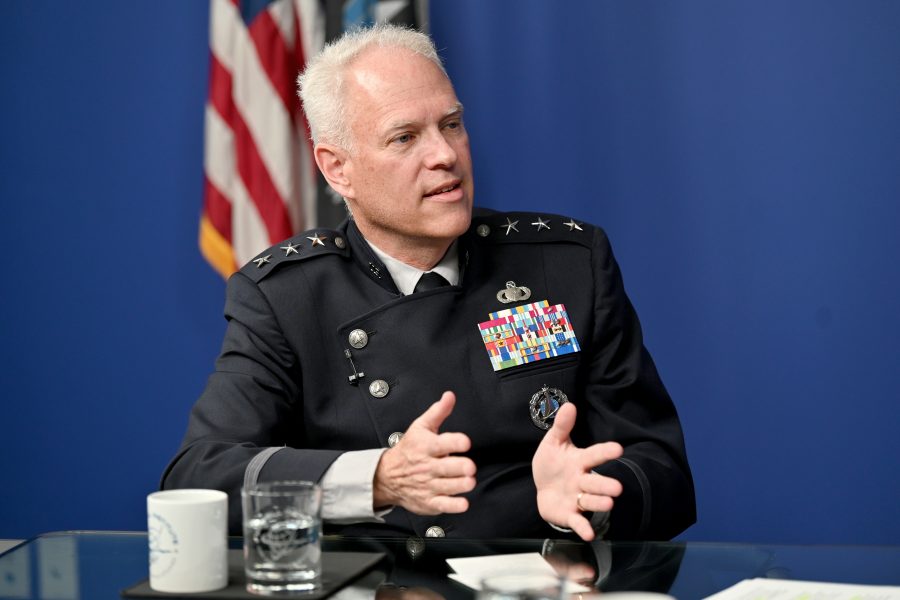The Space Force is finalizing its first contracts for the Commercial Augmentation Space Reserve and plans to award them early in 2025—giving the service access to commercial satellites and other space systems in times of conflict or crisis—officials said Nov. 21.
The idea for CASR, often described as a space version of the Air Force’s Civil Reserve Airlift Fleet, was first raised publicly by then-Lt. Gen. Nina M. Armagno in October 2022 as a way to “surge” capability when needed. Since then, officials have spent the better part of two years refining the concept.
Now the Space Force is on the verge of launching the concept, Space Systems Command boss Lt. Gen. Philip A. Garrant told reporters Nov. 21.
“We’re actually writing clauses for our contracts that would incorporate some of … the framework that allows us to go into crisis and conflict with these partnerships,” Garrant said, speaking at a session organized by the Defense Writers Group. A Space Force official speaking to reporters on background at the Pentagon later confirmed the service is “on track to have our first set of contracts by early next year.”
“We have two ongoing mission areas that we’re looking at: commercial space domain awareness, as well as commercial SATCOM,” the official said. “We’re still figuring out the mission area analysis for commercial SATCOM. We’ve done a lot of the analysis already for the commercial space domain awareness.”
The initial deals aren’t quite “full” CASR contracts, the official added. “We are still figuring out when we start talking about priority of service, denial of service, but also working out the contract clauses on what a full CASR member means,” the official said. “What you’ll see in those contracts will be a level amount of capability on contract during peace time and pre-priced surge, so we know how much it’ll cost.”

USSF got more than 80 responses to a request for information recently, but while industry leaders have expressed interest, some have also voiced concerns about whether agreements might block companies from working with other partners during surge periods and about whether the Pentagon will act to protec companies should participation lead to their assets being targeted in a conflict.
Garrant sees clear benefits for all.
“The advantage to the commercial companies is … participation in more games and exercises, so we are practicing ahead of time, access to threat data at the highest classification that companies can receive—and we can help them with clearances once we have those contracts—as well as cyber defense,” Garrant said. “Of course, the [benefit] to the government is we’ve pre-negotiated that access, and it’s not being done after the fact. So we believe it’s a real relationship. There’s real value, and it’s worth pursuing sooner than later.”
Benefits will kick in fast for the first contract awardees—the Space Force official described plans for a CASR wargame in February.
On top of that, the official noted that the service would be willing to help CASR companies monitor their supply chains for weaknesses.
“These companies are like, ‘Oh, so you’re going to do some free supply chain stuff for us?’ Yeah, I mean, I need it,” the official said. “Why wouldn’t I share that? It dovetails into threat sharing. I need you to have information on this so that you can inform your investments so you know what’s going on in the AOR. So that if you’re going to be a supplier for us, we need you to continue to operate.”
Officials also say the CASR relationship will go beyond extreme emergencies. Just as the Air Force relies on commercial carriers from the Civil Reserve Air Fleet to move much of its passengers and cargo on a day-to-day basis, the Space Force wants to work closely with its commercial providers so the relationship doesn’t have to go “zero to 60” in a crisis, the official said.
The service is drawing another lesson from CRAF: the need to build out a “readiness plan” so that the Space Force can be confident in how to utilize commercial capabilities when the time comes. Garrant wants to extend that thinking to planning and acquisition officials across the Space Force’s mission areas, he said, so they can fully integrate commercial into their strategies.


